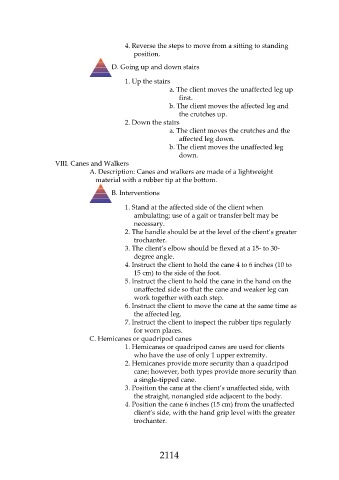Page 2114 - Saunders Comprehensive Review For NCLEX-RN
P. 2114
4. Reverse the steps to move from a sitting to standing
position.
D. Going up and down stairs
1. Up the stairs
a. The client moves the unaffected leg up
first.
b. The client moves the affected leg and
the crutches up.
2. Down the stairs
a. The client moves the crutches and the
affected leg down.
b. The client moves the unaffected leg
down.
VIII. Canes and Walkers
A. Description: Canes and walkers are made of a lightweight
material with a rubber tip at the bottom.
B. Interventions
1. Stand at the affected side of the client when
ambulating; use of a gait or transfer belt may be
necessary.
2. The handle should be at the level of the client’s greater
trochanter.
3. The client’s elbow should be flexed at a 15- to 30-
degree angle.
4. Instruct the client to hold the cane 4 to 6 inches (10 to
15 cm) to the side of the foot.
5. Instruct the client to hold the cane in the hand on the
unaffected side so that the cane and weaker leg can
work together with each step.
6. Instruct the client to move the cane at the same time as
the affected leg.
7. Instruct the client to inspect the rubber tips regularly
for worn places.
C. Hemicanes or quadripod canes
1. Hemicanes or quadripod canes are used for clients
who have the use of only 1 upper extremity.
2. Hemicanes provide more security than a quadripod
cane; however, both types provide more security than
a single-tipped cane.
3. Position the cane at the client’s unaffected side, with
the straight, nonangled side adjacent to the body.
4. Position the cane 6 inches (15 cm) from the unaffected
client’s side, with the hand grip level with the greater
trochanter.
2114

